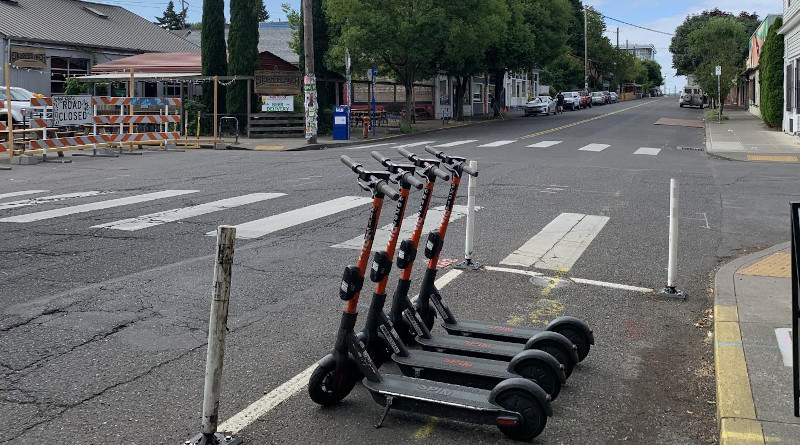Will Automated Vehicles Cut Parking Revenue?
Autonomous vehicles (AVs) will challenge cities in ways that are difficult to fully predict, and yet critical to address early. A particular challenge is the potential for AVs to upset municipal budgets, as they upend traditional auto-related funding streams like vehicle registration fees and parking revenues. To prepare for this uncertain future, cities should practice scenario planning to understand revenue implications and identify alternative solutions.
As a proxy for AVs, researchers often examine transportation network companies (TNCs) like Uber and Lyft, because in many ways they operate as AVs will. In a 2019 NITC Small Starts project, “How Will Autonomous Vehicles Change Local Government Budgeting and Finance?” Benjamin Clark of the University of Oregon (UO) examined Seattle’s parking demand and revenue implications for several downtown neighborhoods.
Building on that work, Clark and UO colleague Anne Brown took a deeper dive into how new transportation technologies affect on-street parking revenues. Expanding their analysis to the entire City of Seattle, they compared Uber trip data with built environment and parking data from the City. The goal was in part to learn what other localized factors, including TNCs, might explain changes in parking demand. They found that up to a certain point, more Uber trips meant more parking spaces occupied: each additional 1,000 Uber trips was associated with a 17.1 percent increase in parking occupancy.
Yet findings reveal that the relationship between TNC trips and parking occupancy is not linear. The model predictions show that parking revenues will decline if or when TNC (or possibly AV) trips are about three times greater than the average number of daily trips taken in 2016.
WAIT…SO WHY IS PARKING MORE OCCUPIED?
Intuition might say that more people using Uber should mean less parking occupation. While some travelers may hail an Uber instead of driving, it’s not a simple substitution. Rather than reshuffling a fixed number of travelers from personal cars into Ubers, the advent of TNCs means more people are traveling to and from popular destinations using a combination of modes. TNCs complement other modes and may enable more people to travel on preferred routes and at more convenient times. The data used in this study do not provide insight into which TNC trips substitute for driving, which carry people who previously traveled by other modes or at other times of the day, or which are new trips entirely. Additional research is needed to better understand the potential mode shift dynamics between driving, TNCs, and other modes.
POLICY OPTIONS FOR CITIES
The analysis presented in this report assumes no policy action by cities. The researchers discuss several possible courses of action in the final report.
Adjust parking policies by time/day
While cities are not in immediate danger of losing parking revenues due to TNCs, parking revenues may erode at high levels of TNCs or AV trip-making. However, TNCs are not the only factor. Parking occupancy and revenue also depend on the local built environment, time of day, number of parking spaces, and parking price. This finding affords a policy opportunity across land uses: Policymakers and planners can adjust parking prices or policies by the time of day, or day of the week, to achieve desired occupancies or outcomes.
Lower parking prices
A simple option would be to lower parking prices to reflect lower demand for parking. However, this approach could run counter to many cities’ efforts to encourage car-alternative travel.
Reduce on-street supply
Instead of lowering prices, cities could maintain parking prices but reduce their on-street parking supply; repurposing on-street spaces for other uses such as parklets, loading spaces, or non-auto parking spaces. This action could produce ancillary benefits such as managing congestion through additional loading spaces, facilitating micromobility with additional non-auto parking spaces, or enhancing the streetscape and public outdoor space.
Find alternative sources of revenue
Many cities are already experimenting with alternative uses for parking spaces: Washington, D.C., recently completed an on-demand, curb-space reservation pilot for a variety of commercial uses including TNCs, food deliveries, and commercial deliveries. Boston, too, is experimenting with similar pilots with some success. In both cases, the city replaced traditional parking revenue with another source (loading zone reservations) while simultaneously addressing congestion issues.
Focus on mixed-use and commercial areas
Per-space parking revenues in Seattle were highest in commercial and mixed-use areas. This may indicate that cities should, in the longer run, focus policy efforts on commercial and mixed-use areas for more revenue opportunities since they are projected to have larger revenue shortfalls. Finding replacements for these revenues, such as the piloted projects in Washington, D.C. or Boston, could help offset projected revenue losses, but may not be a panacea.
WHAT ELSE DO WE NEED TO KNOW?
Parking demand will not disappear overnight. Nevertheless, cities should engage in scenario planning to understand revenue implications as people take more TNC trips–and eventually AV trips–in the coming years. Dynamic analyses are needed to assess how parking rates change in response to higher TNC use, and how those changes could affect revenue.

